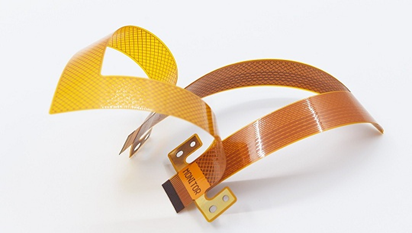Flexible Printed Circuit Board
Flexible PCBs have revolutionized many industries, especially the medical sector, in form-fitting monitoring and biometric patches.

These devices are becoming increasingly vital. What is the technology behind them?
Nearly every electronic device, including phones, TVs, and appliances, are equipped with a printed circuit board (PCB). These boards are made up of laminated conductive insulated layers. They serve two purposes: they house electronic components in designated locations on the outer layers and provide reliable electrical connections between component terminals.
Electronic components , resistors, capacitors, microcontrollers, interfaces, etc., are electronically connected via traces, planes, and other features using a chemical etching process that deposits copper layers laminated onto sheets of a non-conductive substrate.
A Flexible Printed Circuit Board (FPCB) is a type of electronic circuit that offers flexibility in its design and form factor. It is also commonly referred to as a flexible circuit or flex circuit. Unlike traditional rigid printed circuit boards (PCBs) that are made of rigid materials like fiberglass or epoxy resin, FPCBs are made of flexible materials such as polyimide or polyester.
The flexible nature of FPCBs allows them to bend, twist, and conform to irregular shapes or tight spaces, making them ideal for applications where space and weight are critical. They are used in a wide range of electronic devices and systems, including:
Consumer electronics: FPCBs are commonly found in smartphones, tablets, laptops, digital cameras, and wearables.
Automotive : FPCBs are used in various automotive applications, including infotainment systems, control panels, and sensors.
Medical devices: FPCBs are used in medical equipment where flexibility and compact design are essential.
Aerospace and defense: FPCBs are utilized in various aerospace and military applications due to their lightweight and flexible properties.
Industrial equipment: FPCBs are employed in industrial automation and control systems.
FPCBs are manufactured using similar processes as rigid PCBs, such as printing conductive traces on the flexible substrate using etching or screen printing methods. However, they may require specialized manufacturing techniques to handle the flexibility aspect.
Advantages of Flexible Printed Circuit Boards:
Space-saving: FPCBs can be designed to fit into small or irregularly shaped spaces, reducing overall system size and weight.
High reliability: Since there are no solder joints or connectors (as in the case of rigid PCBs), FPCBs tend to have better reliability and durability.
Dynamic flexibility: They can be flexed and bent during operation, allowing them to endure vibrations and mechanical stresses better than rigid PCBs .
Reduced assembly time: FPCBs can eliminate the need for multiple connectors and solder joints, simplifying the assembly process.
Cost-effective: In some cases, FPCBs can replace traditional wire harnesses, leading to cost savings.
Conclusion:
As new technologies are developed, flexible printed circuit boards will keep evolving. Imagine being able to wash a medical monitor device in the washing machine or wear a biometric patch underwater without worrying about corrosion.
Flexible electronics are already able to grab data from the human body. It will be exciting to see where this technology is implemented. This is a brief introduction to flexible PCB design. It will only give an overview of the processes and materials used in their creation.
